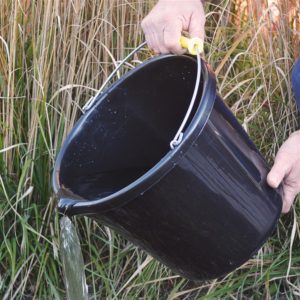
Water, water, water
In the last installment, I covered fertilizing. Once the fertilizer is in place, water the lawn. The ideal situation is to apply the fertilizer prior to a good soaking spring rain, but if you’re busy like I am you’ll likely have to create your own soaking rain with a garden hose and gentle spray nozzle on your own schedule. Water the lawn a few times in the days following fertilizing to help all the granules dissolve and leach into the soil to reach the roots. If there’s an extended dry period, make sure you keep up with the gentle soaking watering every few days.
Overseeding
The next suggestion is almost hard to express in print. I’m not one of those people who enjoys mowing grass. My yard is about an acre, with a house, four outbuildings, a swimming pool, several shade trees, flower beds and a small orchard of fruit trees to mow around. I use a riding mower on the yard, and after two decades of maintaining this property I finally gave in last year and purchased a quality gas string trimmer with a shoulder harness. Still, it can easily take five or six hours to mow and trim around everything. That’s why it seems counter-productive to suggest overseeding a lawn to increase density of grass.
But overseeding has its benefits aside from giving you more grass to cut. Doing so can make the lawn healthier and reduce other weeds by creating a good even healthy mat. Bare spots can make way for dandelions and other weeds to invade.
When overseeding, be sure that you keep the seed you add to the lawn moist. It must be moist to germinate, develop a root system and grow well. Use a rake to scratch up any bare ground areas, apply the new seed liberally, and follow up until the grass is well established. Grass plants don’t live forever. Overseeding regularly every few years or so will help your lawn stay thick and lush.
Mowing
Now to the activity you’ll do over and over until fall. I’ve been told by lawn care experts that you should let the grass grow a little longer than normal before the first cut. Doing so will help the burgeoning stems just waking up from winter gain momentum and strength. In fact, a great way to help ward off spring dandelions is to mow your lawn that first time with the grass a bit higher than than when you would normally mow. Longer grass stems are hardier and help shade out dandelion seedlings.
If you insist on continually manicuring the front 40, or whatever size your lawn, an ideal length grass length is 1.5 inches. A two inch grass height works well for lawns that see hard “wear”, such as areas when children play. Our front lawn often did double duty as a softball diamond when our kids were younger. Nowadays the same area holds rows of apple and peach trees. I used to cut the grass with the mower set on high, but now I’ve dropped the deck to a mid-range setting to provide a trimmed canvas for the little orchard.
Some mow on a regular schedule, cutting the grass every so many days. Be aware that as the weather gets warmer, this system can break down, especially if the grass is growing slowly in a dry spell. Mow only when the grass is at the proper height for mowing, not because your schedule says you should mow!
Look for the final installment on lawn care–solutions for pests and weeds, the bane of every lawn.






























[…] In the next installment, I’ll look at the importance of proper watering, overseeding and mowing. […]
[…] ← Previous Next → […]